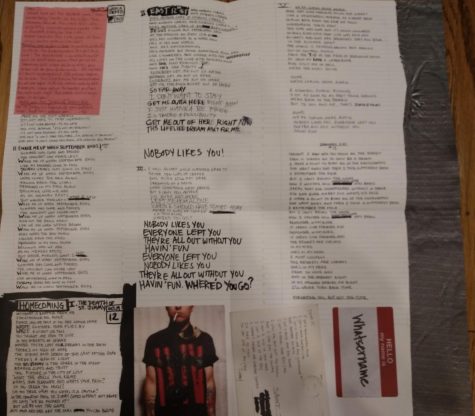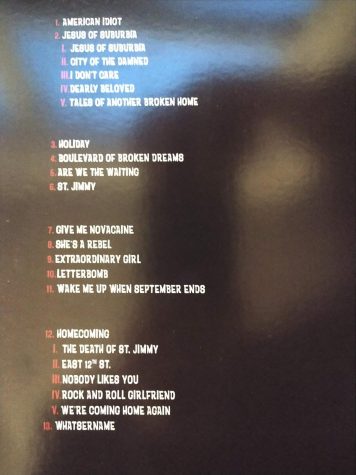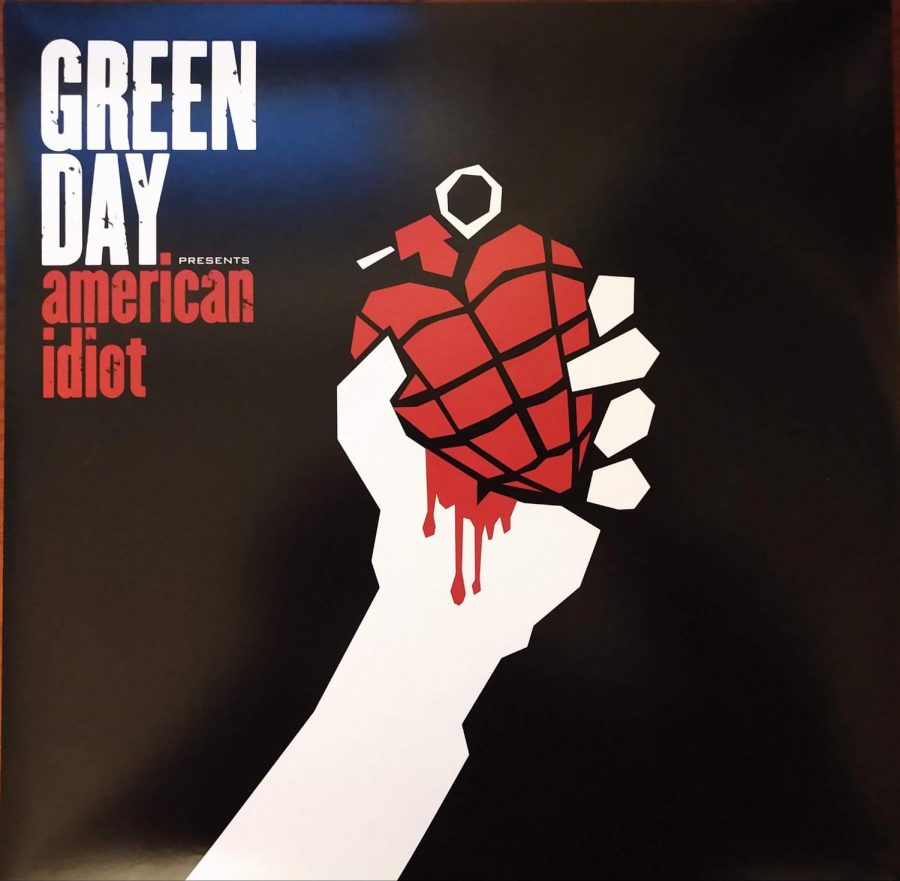American Idiot- At 13 and at 30
April 13, 2021
I recently enjoyed the overwhelming flood of nostalgia that comes with revisiting a beloved album from my teen years, an album balancing rage and love.
For my 30th birthday, my mother-in-law bought me a 4-sided vinyl release of Green Day’s 2004 punk-rock opera “American Idiot.”
A rock-opera, for those unaware, is a concept album featuring interconnected songs that weave a narrative of characters and themes. “American Idiot” was not my first rock-opera, that award goes to “Bat Out of Hell,” but it is notable for totally defining my interest in music, storytelling, and rebellion.
The album, released September of my eighth grade year, marked a turning point in my personality, my relationship with my family and the world, my sartorial style, and my musical interests.

It redefined rock and roll, and fashion not only for me, but for many of my peers. The album sold 16 million copies worldwide, and made black t-shirts with a bloody red “heart like a handgrenade” a uniform for many teens.
Before its release, Green Day had been declining in relevance and seemed on the verge of being tossed into the dustbin of 1990s punk/grunge. With “American Idiot”, the band found a whole new cast of characters, a new identity, new fans, and went on to world wide superstardom and a Broadway musical adaptation.
At age 30, let me just say, it still rocks. The soaring vocals, the non-stop rock, the plaintive ballads, and the attention-grabbing lyrics all remain relevant and gripping. This is no nostalgia act; it’s darn good Rock and Roll.
“American Idiot” stands out in my memory in so many ways. From my first introduction to it, and its explicit content, to drowning out the sounds of the world with oversized headphones and my first iPod, to slow dancing at high school dances to songs like “Boulevard of Broken Dreams.”
I must begin with this memory, of everyone in my grade, from emo kids and goths to nerds and preppy kids with popped collars, slowly swaying to “Boulevard of Broken Dreams.” Some couples forming, others dancing alone, but everyone under the spell of Billie Joe Armstrong’s delayed guitar, Mike Dirnt’s thrumming bass, and Tre Cool’s driving drums.
The song, like many on the album, flows seamlessly from the one preceding it: “Holiday.” Where “Holiday” aggressively swung against the government, the international war on terror, and mainstream misinformation, “Boulevard” begins with the echo of the final guitar chord and the sad truth that “I walk a lonely road…” A sentiment similarly echoed by teenagers around the country in cars, in their bedrooms, and in dimly lit high school gyms.
My father introduced me to “American Idiot” on a sunny day as we drove to Wehle State Park for a run on the coast of Lake Ontario. It is the first album labeled “Parental Advisory- Explicit Content” that he bought for me, and the first time we had listened together to an album liberally littered with F-bombs, offhand comments about illicit drugs, and inappropriate slurs.
I am not saying my dad became cool when he introduced me to this album, but he definitely got some street cred. Last weekend we listened again on the morning of my birthday, and he and my brother and I sang our hearts out to these songs of early 2000s teenage rebellion.
For a band of only three members, and a few auxiliary musicians, Green Day puts out a heck of a lot of sound. The lead singer and frontman Billie Joe Armstrong plays electric guitar, acoustic guitar and piano. Mike Dirnt lays down full, pulsing bass lines on every track and Tre Cool experiments with an expansive range of percussion instruments, everything from a standard kit to a glockenspiel and a hand drum called a tabla.

The four sided vinyl is top quality. The 180 gram discs feel substantial, and the sound quality is excellent. In taking photos for this story I finally pulled out the album liner notes, which unfolds to a massive 24 inch square, two sides, hand written lyrics sheet.
It’s impossible for me to even isolate which of the four sides is my favorite. Side one comes out hard with “American Idiot” then sucks you in with the introduction of the storyline of the rock opera in the five part song suite “Jesus of Suburbia.”
Side two’s “Boulevard of Broken Dreams” plays on my nostalgia and is sandwiched between the most punk songs of the album: “Holiday” and “St. Jimmy.”

Disc two is more varied and focuses on the unidentified female character, with side three featuring the broadest range of styles and tempos, including songs like “Extraordinary Girl” and “Letterbomb” and ending with my dad’s favorite: “Wake Me Up When September Ends.”
The storyline of this female rebel, St. Jimmy and Jesus of Suburbia intertwine throughout the entire album, but Green Day decided to leave the interpretation up to the listener, and gives us only hints of the resolution on side four.
The conclusion of the album climaxes in the second five part suite, “Homecoming,” which finds St. Jimmy dead and reminds the listener for the second time that “Nobody Likes You.” The coda or epilogue of the album, “Whatsername” leaves both the characters and the listeners adrift in their thoughts, memories, and burning desire to flip back to side 1.
Although only the opening title track and the third song “Holiday” are explicitly political, the entire album embodies the zeitgeist of the early 2000s in its development of themes around disillusionment, escape, failed heroes, vapid popular culture, and the numbing effects of self-medication and depression.
The entire album is violent, driving, inappropriate, and thought-provoking. It relaunched Green Day’s career, inspired a new wave of pop-punk bands and teens, and completely shaped my high school identity. I wore a lot more black, sought out aggressive distorted punk music, and wallowed in my teen angst, reassured that there were musicians, artists and other teens who could relate to me.


